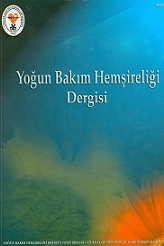Yoğun Bakımda Hipertansiyon
Hipertansif aciller yoğun bakımda sıklıkla karşılaşılan durumlardır. Hipertansif acil durumdaki hastalar, hemodimamik durumların ani şekilde değişebilmesi nedeniyle tedavi, bakım ve izlemi zor olan hastalardır. Bu hastaların tedavi, bakım ve izleminin doğru ve etkin şekilde yapılması hipertansif acil duruma bağlı sekonder sorunların ortaya çıkmasını, ölüm gibi istenmeyen sonuçların önlenmesini sağlamaktadır. Bu derlemede, hipertansif acillerin etiyolojisi, belirti ve bulguları, tedavisi ve izlemi ele alınmıştır. Hipertansif acillerin doğru ve etkin tedavinde yoğun bakım hemşiresinin rolü büyüktür.
Anahtar Kelimeler:
Hipertansif acil, yoğun bakım, hemşirelik
Hypertensive in Intensive Care
Hypertensive emergencies are conditions frequently encountered in intensive care. Hypertensive patients in emergency, it can be changed in rapid succession hemodimamik condition of treatment, patients who are difficult to care and follow-up. Treatment of these patients, the care and treatment of hypertensive emergencies correctly and effectively performed due to the occurrence of secondary problems, provide prevention of unintended consequences, such as death. In this paper, the etiology of hypertensive emergency, signs and symptoms, treatment and follow-up are discussed. Hypertensive emergency is a major role of accurate and effective treatment of intensive care nurses.
Keywords:
Hypertensive emergency, intensive care, nursing,
___
- Dealing with hypertensive emergency and ur- gency: your patient's blood pressure is sky- rocketing. Here's how to defuse the crisis. Nursing 2006 Fall;36 Suppl E D:18-9.
- González Pacheco H, Morales Victorino N, Nşñez Urquiza JP, Altamirano Castillo A, Juárez Herrera U, Arias Mendoza A, et al. Pa- tients With Hypertensive Crises Who Are Ad- mitted to a Coronary Care Unit: Clinical Characteristics and Outcomes. J Clin Hyper- tens (Greenwich) 2013;15(3):210-4.
- Türkoğlu M. Ciddi Hipertansif Yoğun Bakım Ünitesi Hastalarında Tedavi Yaklaşımı. Yoğun Bakım Dergis 2010; 9(3):144-53.
- Varon J, Marik PE. Hypertensive Crises. Crit- ical Care Medicine 2004; 7: 1-10.
- Katz JN, Gore JM, Amin A, Anderson FA, Dasta JF, Ferguson JJ, et al. Practice pat- terns, outcomes, and end-organ dysfunction for patients with acute severe hypertension: the Studying the Treatment of Acute hyper- Tension (STAT) registry. Am Heart J 2009;158(4):599-606.e1.
- Marik PE, Rivera R. Hypertensive emergen- cies: an update. Curr Opin Crit Care 2011;17(6):569-80.
- Pollak CV, Rees CJ. Hypertensive emergen- cies:Acute care evaluation and management. Emergency Medicine Cardiac Research and Education Group 2008; 3:1-12.
- Hays AJ, Wilkerson TD. Management of Hy- pertensive Emergencies: A Drug Therapy Per- spective for Nurses. AACN Advanced Critical Care.2010; 21(1): 5-14.
- İyilikçi L. Yoğunbakım hastalarında rutin mon- itorizasyon. Yoğun Bakımda Girişimler ve Teknikler. Çev.Ed. Yelken BB. İstanbul: Nobel Tıp Kitabevleri; 2005. p.226-45.
- Sayın Y. Hemodinamik izlem. Erişkin Yoğun Bakım Hastalarında Temel Sorunlar ve Hem- şirelik Bakımı. Çelik S, editör. İstanbul: Nobel Tıp Kitabevleri Tic.Ltd. Şti; 2014. s.165-74.
- Bilir A. Arteryal Kateter Yerleştirilmesi ve Bakımı. Yoğun Bakımda Girişimler ve Teknikler. Çev.Ed. Yelken BB. İstanbul: Nobel Tıp Kitabevleri; 2005. s.36-44.
- ISSN: 1302-0498
- Başlangıç: 1997
- Yayıncı: Yoğun Bakım Hemşireler Derneği
Sayıdaki Diğer Makaleler
Kalp Yetersizliği ve Hemşirelik Bakımı
Ayşe ÇİL AKINCI, Neriman ZENGİN, Yasemin BUĞU
Kalp Yetersizliğinde Gordon’un Fonksiyonel Sağlık Örüntüleri Modeli Doğrultusunda Hemşirelik Bakımı
Akut Koroner Sendromlar ve Hemşirelik Yönetimi
